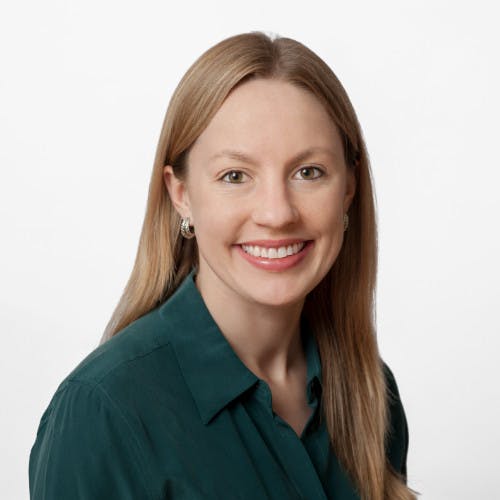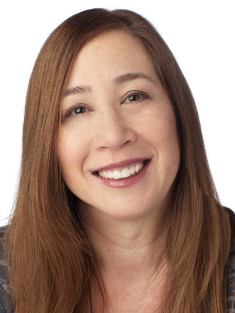Season 10 - Episode 6
Learning Lateral Product Skills by Credit Karma General Manager
Poulomi Damany, Credit Karma General Manager, is our very special guest on this episode of the Product Podcast. Credit Karma is a rocket ship, growing at a fast pace from a small company to a super app serving 120 million people. In this context, Poulomi argues that learning as much as you can laterally is more important than getting that new job title.
Read on for her experience in this super growth company, as well as her thoughts on financial independence, team structure, and what she looks for in PMs.

Your company’s on a rocket ship and we’re going to talk about that in a second, but before I’d like to learn more about your own personal experience. How did you get your first Product Management job?
That’s a really good question. Like most engineers, I started off in the engineering side and building according to what somebody had laid out. And the more I thought about it, the more I wanted to understand the why behind what we were doing. Getting more context, understanding what the user benefit would be, how would we differentiate?
And my engineering manager was like, “Well, you sound like a Product Manager every day. Let’s put you in there.” And so luckily I got a chance to do that. And then kind of fell in love with that whole aspect of being in the middle between here’s the consumer problem you’re trying to solve, here’s our unique ability to do it, and then really figuring it out with the engineers and the designers, what do we build?
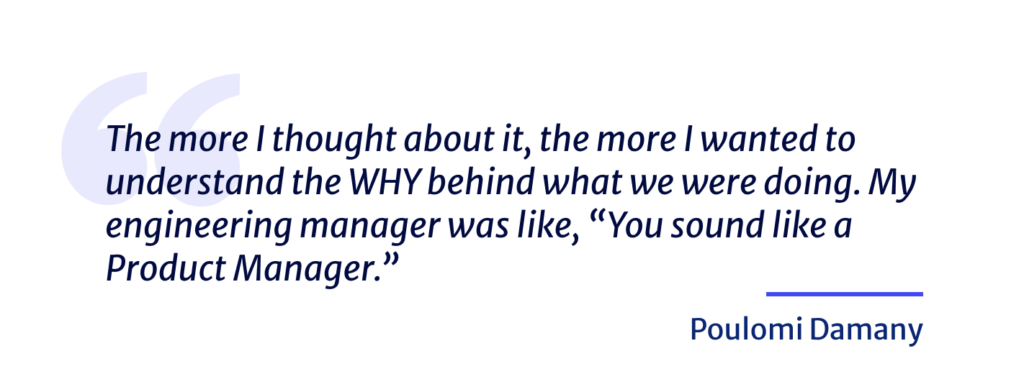
You’ve been at Credit Karma for five years. Your first title there was VP of Product, now you are a General Manager. What is the difference between a VP of Product and a General Manager?
I’ve been blessed at Credit Karma to be able to have different opportunities and different roles, roughly almost every 18 months. I joined in an area that I knew a lot about, I thought, and I could leverage that expertise to help Credit Karma build around data, and systems, and recommendations.
This is something that I have a deep background on, and then started pivoting into more, “Hey, where are the unknown spaces?” We talk about this building environment called Lightbox, where we essentially have helped our banking partners figure out who are the right people on Credit Karma for the right borrowing products with this, a personal loan, or a credit card, and really creating a synergy there on our platform.
So building that set of capabilities and tools, which is more of an enterprise product, to be able to remove that disappointment for our members. Frequently in financial services, you don’t know until you apply whether you’re gonna get it. And so if you wanna have that indicator of like, “Hey, your chances of getting this are great or bad, and so don’t apply, or go ahead and apply.” And giving that confidence.
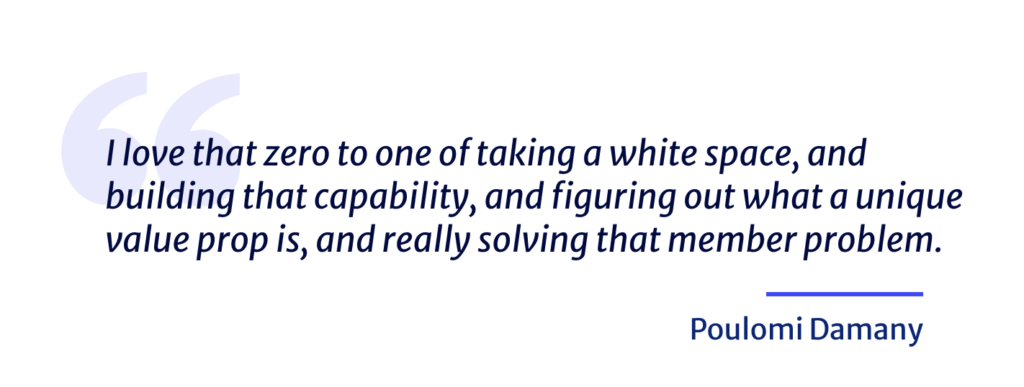
So that started with that consumer-centric view. I love that zero to one of taking a white space, and building that capability, and figuring out what a unique value prop is, and really solving that member problem.
This opportunity came up on Credit Karma money, which as a business unit inside of Credit Karma, where we actually for the first time moved to the other side of the balance sheet. We’ve traditionally been about credit and borrowing, and now this is about your checking, and your spending, and your income, and your savings, and where you wanna go with your wealth opportunity.
I’ll be biased and say, Product People make good GMs, particularly in this space, because they understand all aspects. And they’re used to responsibility without direct authority, which I think has been the number one thing that I’ve learned as a GM.
How do you motivate, how do you energize? How do you get a lot of people behind that vision? How do you share that context? How do you story tell so that everybody’s marching in the same direction? So a lot of transferable skills, and also having the ability to have that product or consumer underpin conversation. So it’s not just about revenue or partnerships.
When you joined Credit Karma, what was the status of the company and how did you personally see the growth of the portfolio of products?
Over five years it’s been a tremendous increase, both in the number and products that we’ve fielded, the acquisition we’ve had in terms of our consumers trusting us more and more.
And then also in the business. I think we started off as, “Hey, how do we build trust around your finances with something called a credit score?” So credit score is a way of banks rating you. And so we were the first in the industry to give it to you for free. So you could understand what your score was, what that meant, how do you improve it, so that gets you into into the debt products that you wanted. And that created a really big engagement loop.
And then the businesses that grew from there were very much around access. We have an ecosystem of partners that we work with. And we did that matching in our marketplaces. So for somebody with a 660 credit score, what’s available to you today, how far away are you from actually getting the things that you want?
Check out: Branding for Builders by Former Netflix VP of Product
We talked about this notion of, we actually tell you all before you even apply. So that allowed us to create a credit card marketplace, personal loans, we’ve added new verticals there with with home, with mortgages, with auto insurance, auto loans. That’s an extensible model for us, even though each of those spaces come in with their own regulations and their own customer journeys and so on.
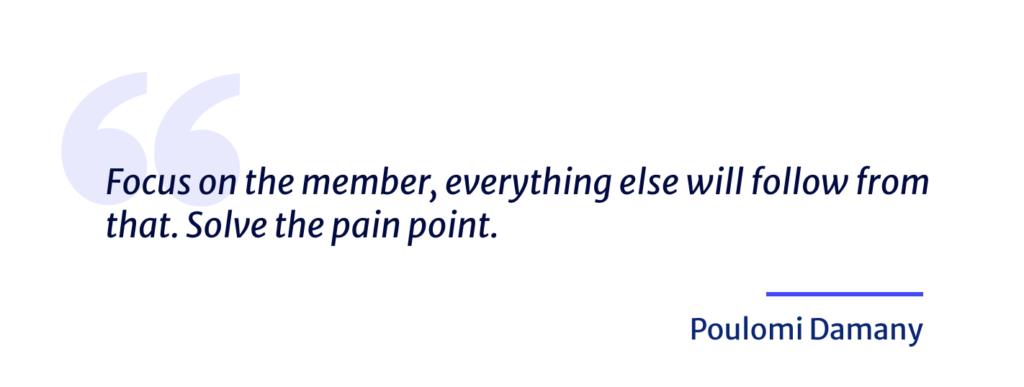
We expand our ambitions. We saw so many people trust us with these recommendations that we thought, Okay, well, we’re moving from being the free credit score to recommendations about what you should get. How do we help you automate some of that? How do you remove some of that financial anxiety so that you take the steps to improve your financial life and actually make financial progress?
That’s where our next mission really is, around enabling and automating financial progress for our 120 million members. And that’s where I see consumer experience, data and insights, and access to those products that we care of. For me, money is around, how do I give people unbanked, underbanked access to their first checking account or their first savings account.
You were doing product led growth before that was mainstream, this free product that a lot of people could access to just build trust and to get some value. And then from their use, have the opportunity to expand into other offerings. I think that’s it’s a good lesson there that can apply to other companies and products beyond just finance.
Very much so. Our CEO Ken—and it’s a founder led company in that sense—is very much about, focus on the member first. Credit Karma users are call members. Focus on the member, everything else will follow from that. Solve the pain point.
Dive in: Your Guide to Product Led Growth
How do you go about structuring your org chart and product teams to make sure that you can support all the different products that you’re building?
First of all, in Credit Karma we are verticalized. Every business unit is fully verticalized in product, and business, and marketing together. Engineering is centralized because it reports into our CTO, but they’re dedicated to a particular business. So I think that’s kind of the structure that we have.
What it allows us to do is, bring all aspects of that product line together and really make decisions quickly and be able to experiment and iterate a lot faster. As opposed to try to globally prioritize some backlog. That’s been super efficient.
Read next: The Many Ways to Scale a Product
And then depending on whether you are a scaled product line and business to something like us, we’re very much emerging, you wanna structure the team differently. The way I’ve organized my team is there’s essentially a three squad model.
There’s the activation like, how do we get people in to try the product and use the product? There’s the usage piece of it, which is how you continue to keep them sticky and driving that engagement. And the last one is retention and engagement. Outside of using the product—in our case, it’s like here’s your debit card, or putting money in a savings account—how to keep you engaged around your insights, your transactions, what you’re seeing, your bill is due, your paycheck just landed. So driving that retention and engagement and stickiness with the product.
Those are how I’ve organized my team in terms of squads. And that really helps give clarity. Because then they know what they’re looking at. They know what metric they’re driving, they know what customer problems they own versus the other squad, and drive from there.
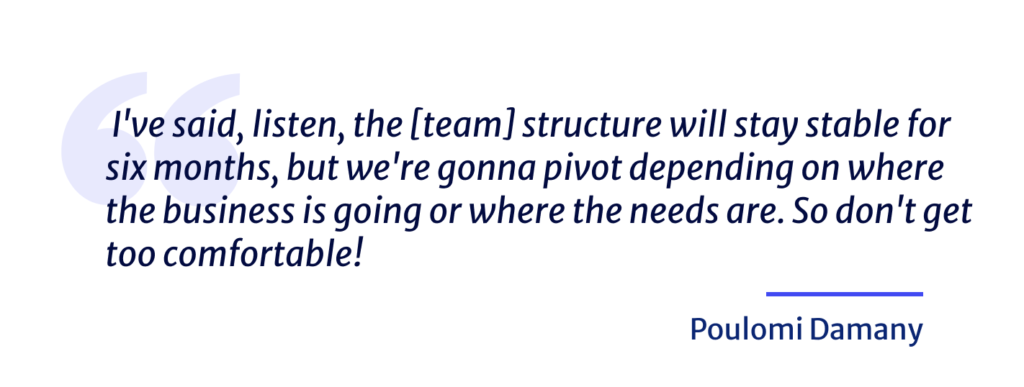
And how do you create that alignment between all those different lines and squads, just to make sure that everyone understands the overall division.
Yeah, really. We were a handful of people who started a year and a half ago, to, we’re in double digits right now. And so really setting two big things. One is having a weekly sync with the leads, where it’s, “Tell us what you did, tell us what you tried, tell us where you failed, and what are you gonna do next?” It’s an opportunity for us to exchange insights and be like, well, are you really driving what you think you are driving? I think having those checkpoints has been really important. We do a common planning process as well, we reconcile.
And then at the end of the day, we are one app. Credit Karma is a super app, essentially. And so we have to fit into that piece of it. So there’s no clear answer. I think it’s more communication, and having these checkpoints and rituals.
And every Friday we have a demo day, where you come in and you present something new to whoever wants to come in and sign up. We do a three by three: three things that I’m working on, three things I’m worried about. And so we do a lot of those kinds of informal meetings where people are just excited and interested in understand what’s happening.
A related read: Culture Building for Product Leaders
I’m always curious about how Product Leaders organize their teams because as you said, there’s no right or wrong answer. And I’m sure it evolves with the product as well.
Very much. And I’ve said, listen, the structure will stay stable for six months, but we’re gonna pivot depending on where the business is going or where the needs are. So don’t get too comfortable! I think that’s one thing.
The other thing you wanna think about is, and this may be something that especially when you’re starting out in your career, you’re very much about like, “Well, how is this gonna get me to the next level? How do I make progress? When will I become a manager?”

And really what I’m trying to do is say, Hey, when you’re on a rocket ship, when you’re in such a big area where there’s so much ambiguity, it’s more important to do lateral stuff. It’s more important to learn. It’s more important to like build different skills than it is to be like, Oh, I did this. Then I became a Principal Product Manager, and I became a Group PM, and so on and so forth.
And that diversity of experiences really helped me. I went from being an engineer, to being like a hardcore backend systems, to a consumer experience, to now a GM. Because I had enough of those things in my toolkit. And that’s where you really should be spending a lot of your time as a Product Manager.
Check out this podcast episode: What Does a Career in Product Look Like?
We actually had a GM from Intuit, for the Mint product on the podcast. This is before the acquisition. With all the other entry products, how do you make sure that you stay independent while at the same time connected with the other companies?
Yeah. It’s a really good question, we get asked that a lot. The structure is, Credit Karma is a wholly owned subsidiary of Intuit. So the only thing that really has changed from a practical perspective, is: my boss, Ken Lin, who’s the CEO of Credit Karma, now has a boss. I don’t even have an email account on Intuit.
And the idea was, let’s pivot this. Don’t integrate for the sake of integrate, integrate to accelerate either our business or their business. Really focus with the consumer in mind and the business in mind. That removes a lot of like, “Hey, I think that could be interesting. Oh, maybe you have this data and why don’t we just send that across?” If you spend a lot of time in that kind of discovery, you paralyze the business.
So it’s very focused on, what are the things we wanna align on that we know will accelerate us, and let’s go work on those and put teams behind that. And independence is earned, right? Because we’re able to be successful in that mode, and we’re able to accelerate—and Credit Karma has really accelerated growth, you can see that in the post-pandemic view. That model is working. And so people tend to trust it more because it is working now.
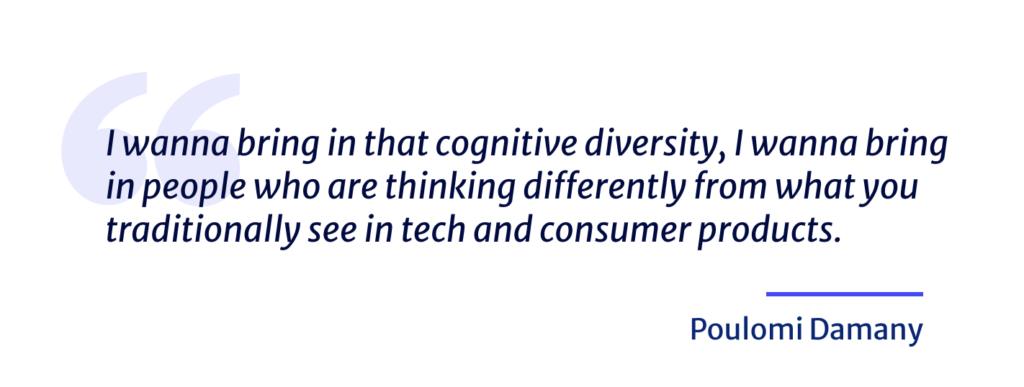
I want to learn how you go about building your own product team. You mentioned that you started as an engineer, someone gave you an opportunity. Now you’re in a position to hire Product Managers. So how do you go about hiring PMs?
That’s a good question. It’s an art, definitely, and not a science. But I would say there’s a few things that have worked. One is, we have a very structured interviewing process. So we test on those six PM skills that we care about.
That’s strategy, that’s consumer design, that’s problem solving, collaboration, execution ability. We test for those in the interview process. The other thing I always make sure is that there’s at least one or two women in the interview rounds. Because I wanna bring in that cognitive diversity, I wanna bring in people who are thinking differently from what you traditionally see in tech and consumer products. That’s been important for me.
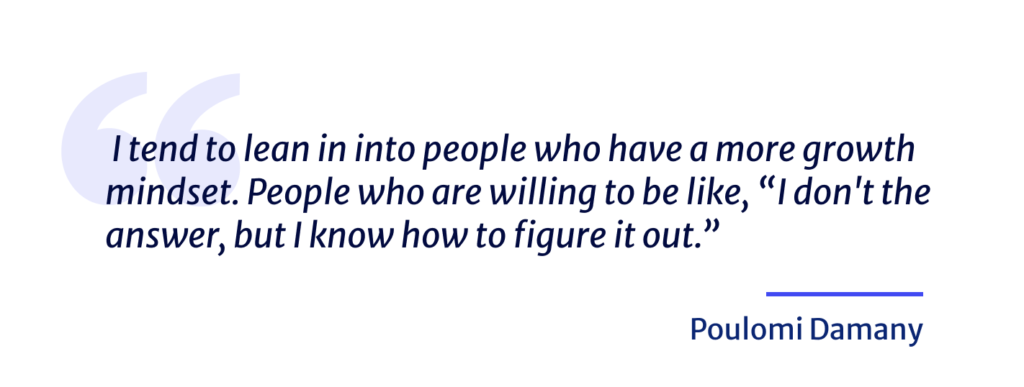
And then I tend to lean in into people who have a more growth mindset. People who are willing to be like, “I don’t the answer, but I know how to figure it out.” As opposed to deep domain expertise. You do need domain expertise in certain areas, particularly in regulated industries. But I feel like that can be learned over somebody’s mindset of like, “How do I approach the problem? How do I keep it bigger and continue to innovate there?”
Learn more: Product Leadership Skills: Building a Strong Product Team
We spend a lot time helping people break into product. You mentioned diversity, which I think is really powerful and necessary. In terms of the skills for someone who doesn’t come from your traditional technical background or MBA, are there any other signs that can tell you that this person can be a fast learner?
Yeah. If you look at their career progression, I look at, what are the different things they’ve done? What kinds of things have they touched? Where have they stepped up and taken an opportunity to lead, where have they failed? You learn a lot about people and how they approach failure, and what they do about it, and what they took away from that failure.
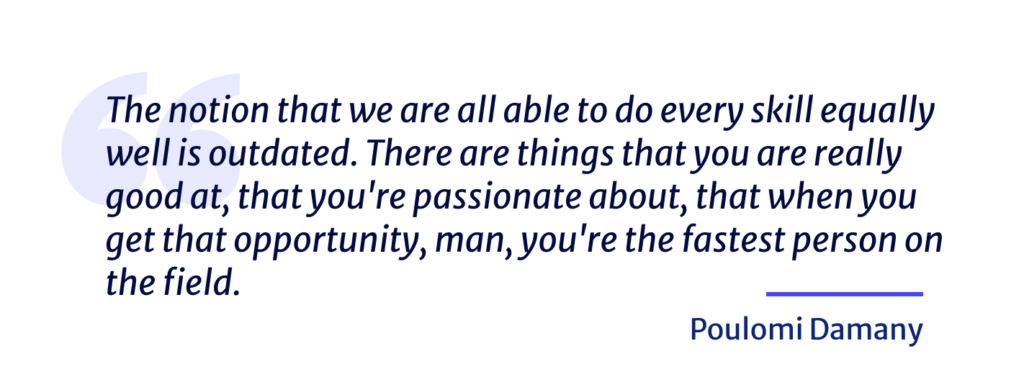
And then last is, I see sort of some sort of, one area of spike. I think the notion that we are all able to do every skill equally well is outdated. There are things that you are really good at, that you’re passionate about, that when you get that opportunity, man, you’re the fastest person on the field. I wanna look for those spikes because that’s what you wanna double down.
And then you have to be good enough at everything else, but you know you’re gonna be successful because you’re great at pixel design, or you’re great at figuring out a really complicated tech issue, or you’re a great storyteller. Whatever that is. That’s the thing that I look for, like, where is your spike? Where do I see you really leaving the rest of us behind?
That’s a great point because there are a lot of people who want to be Product Managers for the wrong reasons. From the outside, you may think that you’ll be coming up with all of these ideas, telling people what to do, which is not true at all. It’s a lot of context switching and not enough time to really go deep in a lot of things. There are a lot of good specialists who really love being the best at something, and may prefer to do that. Instead of getting distracted constantly and being in the middle. They end up being frustrated because they don’t have enough time to do what they love.
Yes. Product Management, particularly in Silicon Valley gets a lot of like, “Oh my God, you guys are the special people. Everybody wants to talk to you.”
And I think what you really realize is—and I did this when I transitioned from engineering to product—you just have to be really comfortable with ambiguity. As an engineer, it’s very black and white, you know what you’re gonna be doing. You know how you’re gonna solve it. And you know what’s gonna get shipped, even though you have a little bit of unknown.
Then as a Product Manager. You’re like… I think this is a good idea. We’re gonna try it. It might be wrong. We may have to U-turn. You just have to be careful, you have to be okay with that.
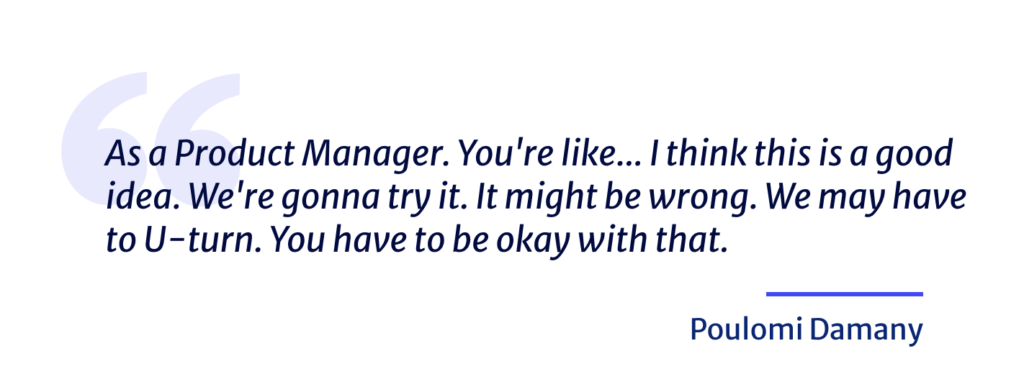
I come from an engineering background too. And yeah, I don’t remember those days where I had no meetings. Now my life is 30 minute blocks on my calendar.
And that’s the thing, that’s the other piece as well. You’re just constantly trying to figure out and hold that context across all of that. I think that’s one.
I think the other one is really this ability to influence without authority. You don’t have direct line responsibility on somebody. That legal person, or that engineer, but somehow they still have to believe in what you’re saying and agree to do the thing you want them to do. So that aspect of being able to bring people along, and share the context, and recruit your little army, that’s a skill that good Product Managers always have.
Now that you are in a much more advanced position in your career than when you started as a PM, what are you curious about learning these days?
What am I curious about learning these days? Workwise, I’m really, really interested in how do we increase access to financial products? And so there’s a lot of new, interesting things happening around open banking, and distributed finance, and even some of these newer scarier products like crypto, et cetera. So I’m really interested in learning about that and how can that translate into getting people into a better financial situation.
And then the other piece on this is, you said we shouldn’t talk too much about the pandemic, but I’m really, really interested in this digital health piece. It’s the first time I’ve seen where, very similar to tech, medicine collaborated. We did open sourcing of the virus. And so a lot of people could work simultaneously on finding cures and finding vaccines and so on. That’s the second big area, which is, how do we make access to medical things more egalitarian and more available. Because whether we like it or not, we’re a connected world.
I were to take a peek into your calendar today, what would be the main thing? How do you spend your time?
First of all, I have an executive assistant (EA), who—bless her heart. If I didn’t have her, I would die. I wouldn’t know what to do with my time. She manages the calendar Tetris.
But I have dedicated times or days in which I’m like, Okay, I’m gonna zoom in into the product, or I’m gonna go do this thing, or I’m gonna spend this afternoon having my one-on-ones. So I try to dedicate time across that.
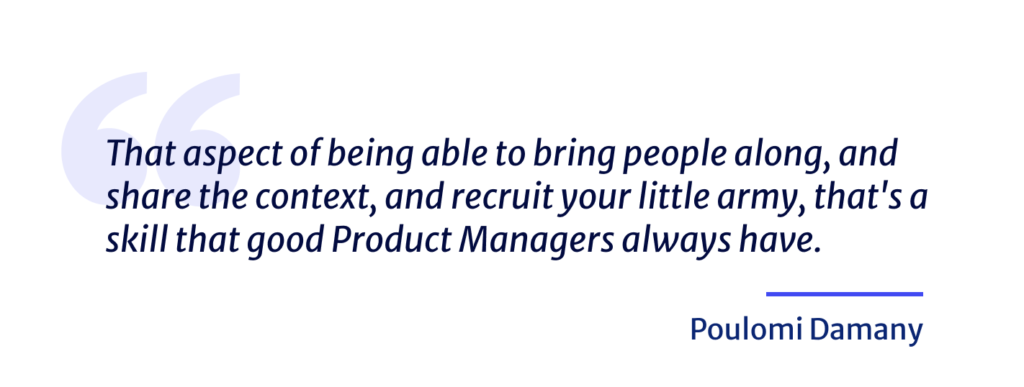
Emily, my EA has now started adding 15 minute breaks in there to be like, breathe. It’s just called Breathe. And I’m just like, Oh, that’s great. I have 15 minutes before the next thing. And it gives me time to prep, and do things.
The last thing that I’m trying to do, not always successful, is really take time out and be like, this is an hour. I don’t want any meetings. I just wanna think about the things that are up there, or things I need to do, or work on things. And go from there.
I love that 15 minute buffer, I think it’s important to not forget about yourself. You’re human too. And switching context takes a toll. Going from a legal meeting, to finance, to engineering. And then just being prepared to really be the best for others is something that took me time to learn, and I’m still working on it. But I also do that thing of creating a buffer in between meetings just to prep and breathe.
It was easier when we were in the office, because you were walking to something and you got that little bit of a mental break, or you had a conversation. Now we’re like, eight hours of video. And I hadn’t realized how draining that is, just being on all the time in front of a screen and not having that break to step away.
Totally, and water.
Water, bathroom. And lunch!
You mentioned part of the future of finance, you’re interested in new financial models, cryptocurrency, and so on. What is your take, considering that you have a business that is working?
Credit Karma is a cross section of America. We have 120 million people. Everybody from the young and just starting out, to people who are sort of have lots of opportunity for wealth creation. So we look at four member segments.
These are people who are slipping backwards, who, one little thing can put them on the path to a debt cycle. Staying afloat, living paycheck to paycheck. Building momentum, they’ve got a little bit of savings, they have a little bit of a cushion. And then finally, navigating opportunity, which is where there’s wealth creation.
We have that entire spectrum on Credit Karma. And so I’m thinking about, how do you draw people along that curve. How do you take somebody who’s living paycheck to paycheck, to getting them to save for that rainy day fund, and eventually building 5 thousand, 10 thousand dollars to then now create wealth, which gives them independence and opportunity and other things. So that’s where this is coming in.
You basically broke these down into user personas, which makes so much sense. Because from the outside, we’re all logging into the same product, but there’s a lot of data that personalizes the experience, just to make sure you’re providing the right next step.
Yeah. There’s no point in giving sophisticated financial advice to somebody who’s got $5,000. Right. And the same way, with somebody who’s got $50,000 to invest, you want a different set of skills and a different set of tools.
You might also be interested in: 4 Steps to Create a User Persona
If you were to give advice to your younger self, not like, how would you change your life? But like, let’s say you would want to be where you are, just a little bit faster. What would you have done differently?
Yeah. I started talking about this. So I think one of them is try a lot of different things. I always say, date a lot in terms of the jobs and the projects and the things that you work at, so you understand yourself. You understand what you’re good at. You understand what you like and what you don’t like, where you need to work on yourself more. I think that’s one.
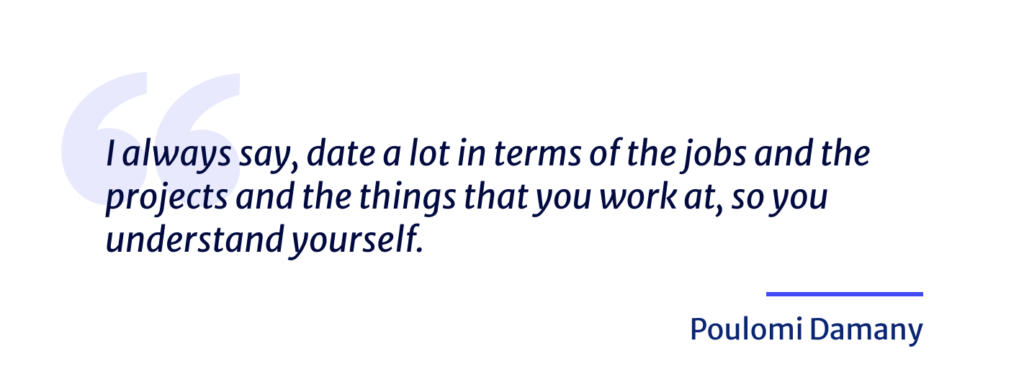
I think the other one is follow the people that you admire. Find your board of directors, find those mentors, find those people who are like, I see something in you here, let me help you tweak it and shape it better. We all benefit from personalized coaching. So find those people in your lives who care about you.
And they can be your friends. They can just be people who are very honest and objective with you. And they can be people at work who are further along in their career and can see where you might be making mistakes. I think I tended to do a lot of these things on my own. And that is something that I’ve learned, to lean on other people. I think that’s been good.
And then not getting hung up the career ladder. For me, it was a sign of competency that I moved up, and I got a promotion, and I got a team. And not really.
It’s not really a sign of your competence. It’s a reward for sure, but it’s not really calibrated to where you wanna go, where you think you’re good at, and what your next thing will be.
Listen to our episodes on your favorite platform
Stay tuned for new episodes
By sharing your email, you agree to our Privacy Policy and Terms of Service

